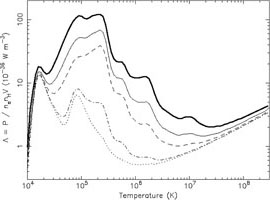


The cooling of a plasma by thermal radiation is usually expressed by the
cooling function
 (T). This
is essentially the bolometric
power P emitted as thermal radiation by the plasma, normalised by
the emission measure Y = ne nH
V. Accordingly, the characteristic cooling time, defined as the
thermal energy of the plasma divided by the emitted power,
tcool = 3/2
(1 + ni / ne) k T /
(T). This
is essentially the bolometric
power P emitted as thermal radiation by the plasma, normalised by
the emission measure Y = ne nH
V. Accordingly, the characteristic cooling time, defined as the
thermal energy of the plasma divided by the emitted power,
tcool = 3/2
(1 + ni / ne) k T /
 nH.
nH.
Cooling is important for the evolution of several plasmas such as the
cool cores of clusters but also for the global evolution of the WHIM. A
set of useful cooling curves are given by
Sutherland
& Dopita (1993).
An example is shown in Fig. 15. These are valid
under CIE conditions. When photoionisation is important, modifications
are needed. Here we have normalised
 to the emission
measure of the
plasma, but note that sometimes other scalings are being used (for
example expressions containing the ion density ni or
ne2). Note that the Solar abundances used
in Fig. 15 are the older values of
Anders &
Grevesse (1989)
which differ significantly from more recent estimates, for example
Lodders (2003),
in particular for important coolants such as iron (new values 26%
lower) and oxygen (new values 32% lower). The big hump at low
temperatures is produced mainly by line radiation, while the high
temperature ~ T0.5 tail above 107 K is
mainly produced by Bremsstrahlung.
to the emission
measure of the
plasma, but note that sometimes other scalings are being used (for
example expressions containing the ion density ni or
ne2). Note that the Solar abundances used
in Fig. 15 are the older values of
Anders &
Grevesse (1989)
which differ significantly from more recent estimates, for example
Lodders (2003),
in particular for important coolants such as iron (new values 26%
lower) and oxygen (new values 32% lower). The big hump at low
temperatures is produced mainly by line radiation, while the high
temperature ~ T0.5 tail above 107 K is
mainly produced by Bremsstrahlung.
 |
Figure 15. Cooling curves
|
Finally, a more recent set of cooling curves, suited in particular for lower temperatures and primordial gas, was published by Maio et al. (2007).